Assessment 1 Workbook: NSB334 Integrated Nursing Practice 4
VerifiedAdded on 2020/05/28
|23
|4707
|665
Homework Assignment
AI Summary
This assignment is a workbook solution for the NSB334 Integrated Nursing Practice 4 course, focusing on a collaborative practice simulation centered around a patient named Mr. Dwight, who has a history of bowel cancer and is receiving palliative care. The workbook explores various aspects of Mr. Dwight's case, including his signs and symptoms prior to diagnosis, the anatomy and physiology of his hemicolectomy and colostomy, risk factors for bowel cancer, and his elevated blood glucose levels. It also delves into the use and importance of nasogastric tubes, routine checks, and social circumstances assessments in palliative care. Furthermore, the assignment analyzes assessment items in the emergency department, medication prescribed for pain management, and the prioritization of clinical assessment findings. The solution provides detailed answers to each question, incorporating relevant medical knowledge, nursing interventions, and critical thinking skills.
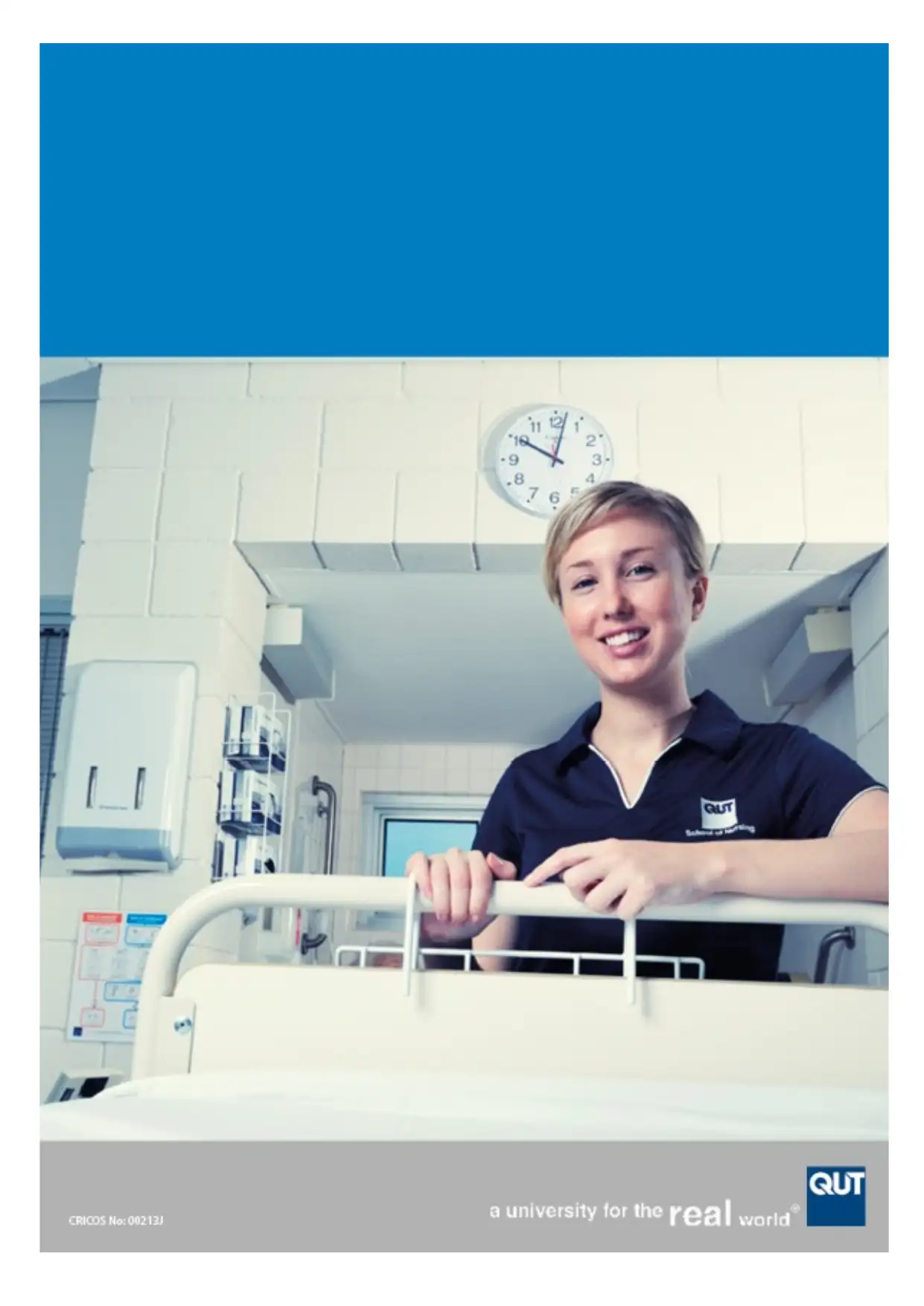
Paraphrase This Document
Need a fresh take? Get an instant paraphrase of this document with our AI Paraphraser

School of Nursing
ASSESSMENT COVER SHEET
Student Name: Student No.:
Unit Name: Integrated Nursing Practice 4
Unit Code: NSB334 Due Date:
Lecturer’s/Tutor’s Name:
Tutorial Day/Time:
Assessment No. 1 Assessment Title: Collaborative Practice Simulation
Bachelor of Nursing Page 2 of 23
NSB334 Integrated Nursing practice 4
ASSESSMENT COVER SHEET
Student Name: Student No.:
Unit Name: Integrated Nursing Practice 4
Unit Code: NSB334 Due Date:
Lecturer’s/Tutor’s Name:
Tutorial Day/Time:
Assessment No. 1 Assessment Title: Collaborative Practice Simulation
Bachelor of Nursing Page 2 of 23
NSB334 Integrated Nursing practice 4
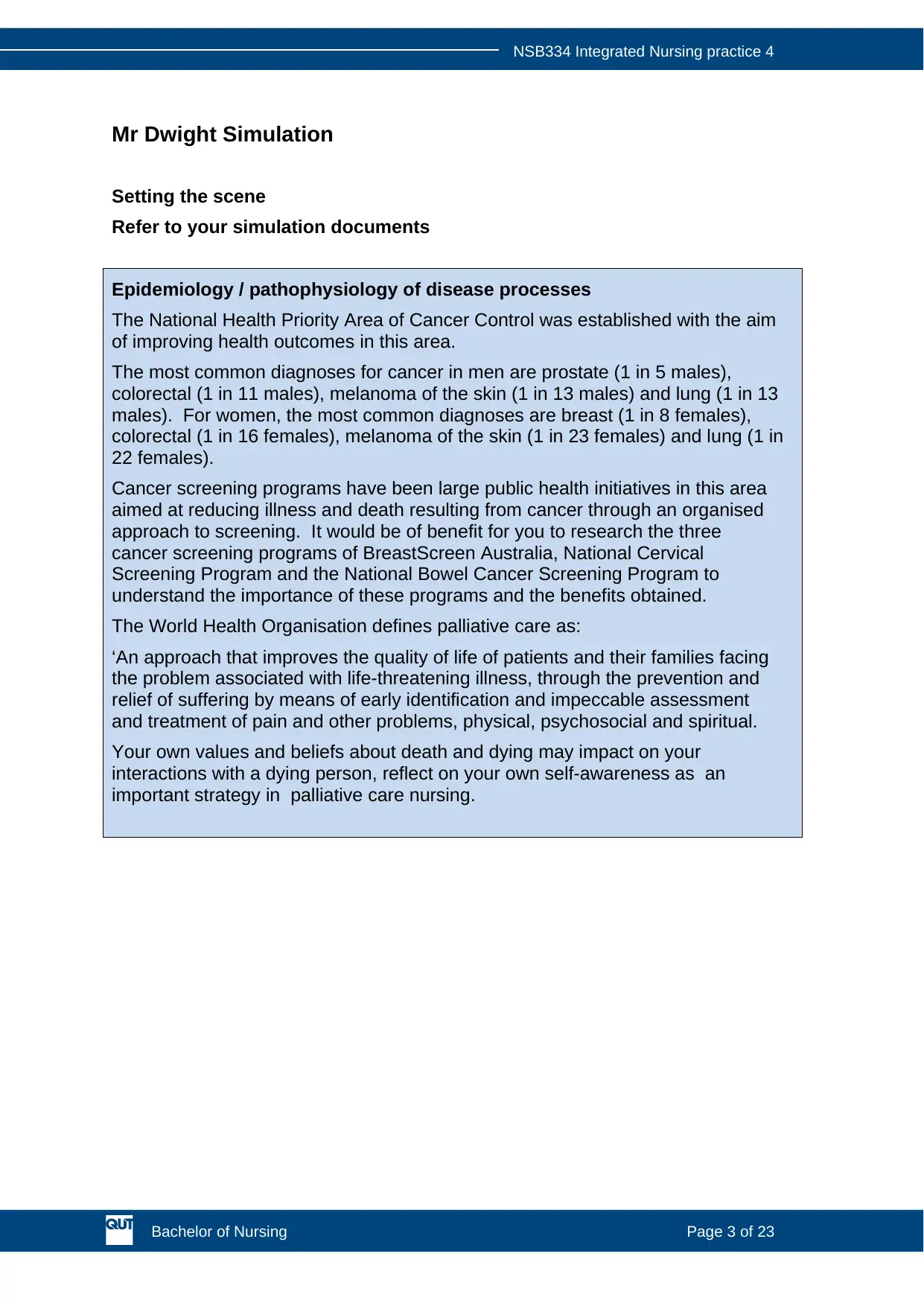
Mr Dwight Simulation
Setting the scene
Refer to your simulation documents
Epidemiology / pathophysiology of disease processes
The National Health Priority Area of Cancer Control was established with the aim
of improving health outcomes in this area.
The most common diagnoses for cancer in men are prostate (1 in 5 males),
colorectal (1 in 11 males), melanoma of the skin (1 in 13 males) and lung (1 in 13
males). For women, the most common diagnoses are breast (1 in 8 females),
colorectal (1 in 16 females), melanoma of the skin (1 in 23 females) and lung (1 in
22 females).
Cancer screening programs have been large public health initiatives in this area
aimed at reducing illness and death resulting from cancer through an organised
approach to screening. It would be of benefit for you to research the three
cancer screening programs of BreastScreen Australia, National Cervical
Screening Program and the National Bowel Cancer Screening Program to
understand the importance of these programs and the benefits obtained.
The World Health Organisation defines palliative care as:
‘An approach that improves the quality of life of patients and their families facing
the problem associated with life-threatening illness, through the prevention and
relief of suffering by means of early identification and impeccable assessment
and treatment of pain and other problems, physical, psychosocial and spiritual.
Your own values and beliefs about death and dying may impact on your
interactions with a dying person, reflect on your own self-awareness as an
important strategy in palliative care nursing.
Bachelor of Nursing Page 3 of 23
NSB334 Integrated Nursing practice 4
Setting the scene
Refer to your simulation documents
Epidemiology / pathophysiology of disease processes
The National Health Priority Area of Cancer Control was established with the aim
of improving health outcomes in this area.
The most common diagnoses for cancer in men are prostate (1 in 5 males),
colorectal (1 in 11 males), melanoma of the skin (1 in 13 males) and lung (1 in 13
males). For women, the most common diagnoses are breast (1 in 8 females),
colorectal (1 in 16 females), melanoma of the skin (1 in 23 females) and lung (1 in
22 females).
Cancer screening programs have been large public health initiatives in this area
aimed at reducing illness and death resulting from cancer through an organised
approach to screening. It would be of benefit for you to research the three
cancer screening programs of BreastScreen Australia, National Cervical
Screening Program and the National Bowel Cancer Screening Program to
understand the importance of these programs and the benefits obtained.
The World Health Organisation defines palliative care as:
‘An approach that improves the quality of life of patients and their families facing
the problem associated with life-threatening illness, through the prevention and
relief of suffering by means of early identification and impeccable assessment
and treatment of pain and other problems, physical, psychosocial and spiritual.
Your own values and beliefs about death and dying may impact on your
interactions with a dying person, reflect on your own self-awareness as an
important strategy in palliative care nursing.
Bachelor of Nursing Page 3 of 23
NSB334 Integrated Nursing practice 4
⊘ This is a preview!⊘
Do you want full access?
Subscribe today to unlock all pages.

Trusted by 1+ million students worldwide
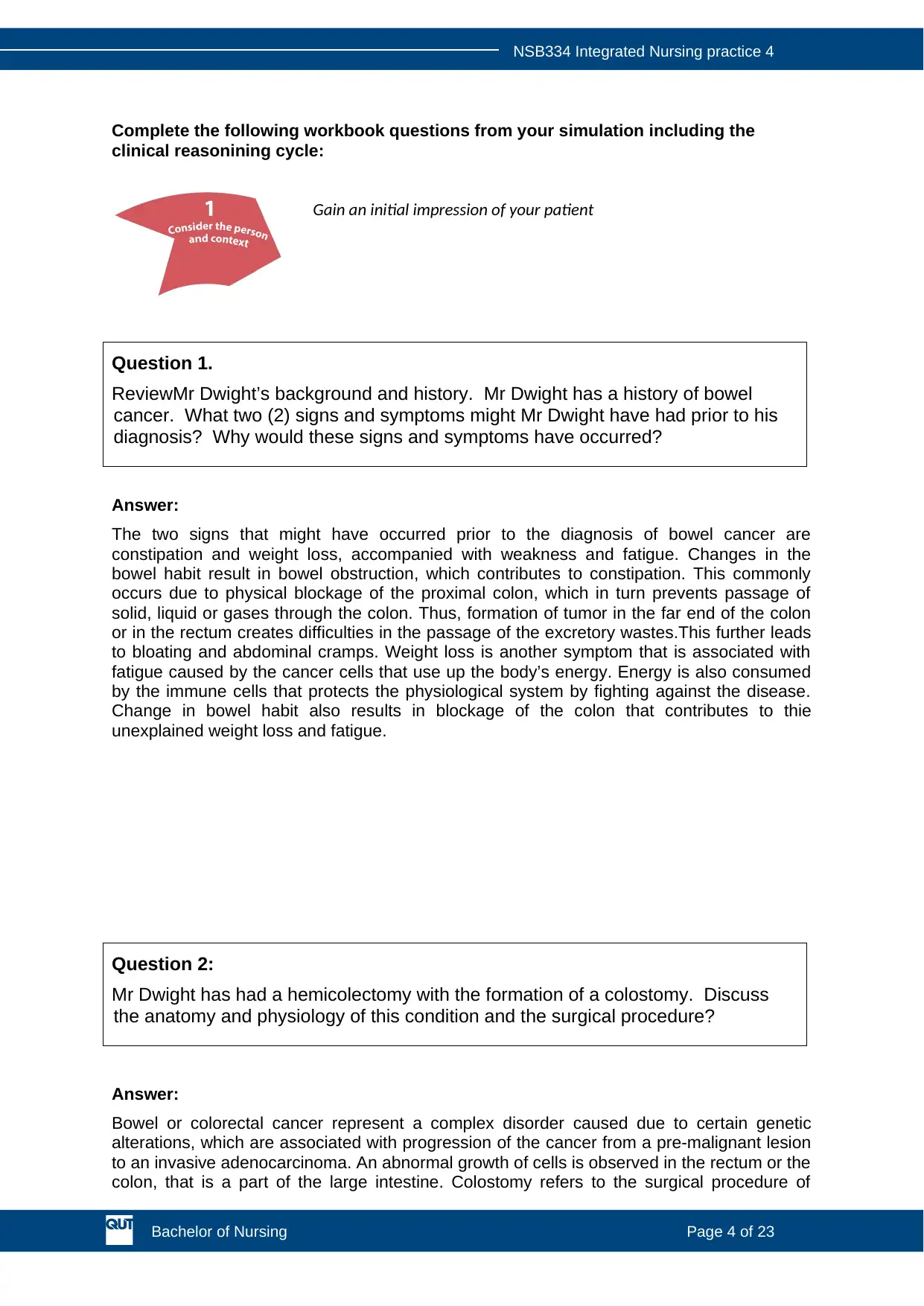
Complete the following workbook questions from your simulation including the
clinical reasonining cycle:
Gain an initial impression of your patient
Question 1.
ReviewMr Dwight’s background and history. Mr Dwight has a history of bowel
cancer. What two (2) signs and symptoms might Mr Dwight have had prior to his
diagnosis? Why would these signs and symptoms have occurred?
Answer:
The two signs that might have occurred prior to the diagnosis of bowel cancer are
constipation and weight loss, accompanied with weakness and fatigue. Changes in the
bowel habit result in bowel obstruction, which contributes to constipation. This commonly
occurs due to physical blockage of the proximal colon, which in turn prevents passage of
solid, liquid or gases through the colon. Thus, formation of tumor in the far end of the colon
or in the rectum creates difficulties in the passage of the excretory wastes.This further leads
to bloating and abdominal cramps. Weight loss is another symptom that is associated with
fatigue caused by the cancer cells that use up the body’s energy. Energy is also consumed
by the immune cells that protects the physiological system by fighting against the disease.
Change in bowel habit also results in blockage of the colon that contributes to thie
unexplained weight loss and fatigue.
Question 2:
Mr Dwight has had a hemicolectomy with the formation of a colostomy. Discuss
the anatomy and physiology of this condition and the surgical procedure?
Answer:
Bowel or colorectal cancer represent a complex disorder caused due to certain genetic
alterations, which are associated with progression of the cancer from a pre-malignant lesion
to an invasive adenocarcinoma. An abnormal growth of cells is observed in the rectum or the
colon, that is a part of the large intestine. Colostomy refers to the surgical procedure of
Bachelor of Nursing Page 4 of 23
NSB334 Integrated Nursing practice 4
clinical reasonining cycle:
Gain an initial impression of your patient
Question 1.
ReviewMr Dwight’s background and history. Mr Dwight has a history of bowel
cancer. What two (2) signs and symptoms might Mr Dwight have had prior to his
diagnosis? Why would these signs and symptoms have occurred?
Answer:
The two signs that might have occurred prior to the diagnosis of bowel cancer are
constipation and weight loss, accompanied with weakness and fatigue. Changes in the
bowel habit result in bowel obstruction, which contributes to constipation. This commonly
occurs due to physical blockage of the proximal colon, which in turn prevents passage of
solid, liquid or gases through the colon. Thus, formation of tumor in the far end of the colon
or in the rectum creates difficulties in the passage of the excretory wastes.This further leads
to bloating and abdominal cramps. Weight loss is another symptom that is associated with
fatigue caused by the cancer cells that use up the body’s energy. Energy is also consumed
by the immune cells that protects the physiological system by fighting against the disease.
Change in bowel habit also results in blockage of the colon that contributes to thie
unexplained weight loss and fatigue.
Question 2:
Mr Dwight has had a hemicolectomy with the formation of a colostomy. Discuss
the anatomy and physiology of this condition and the surgical procedure?
Answer:
Bowel or colorectal cancer represent a complex disorder caused due to certain genetic
alterations, which are associated with progression of the cancer from a pre-malignant lesion
to an invasive adenocarcinoma. An abnormal growth of cells is observed in the rectum or the
colon, that is a part of the large intestine. Colostomy refers to the surgical procedure of
Bachelor of Nursing Page 4 of 23
NSB334 Integrated Nursing practice 4
Paraphrase This Document
Need a fresh take? Get an instant paraphrase of this document with our AI Paraphraser
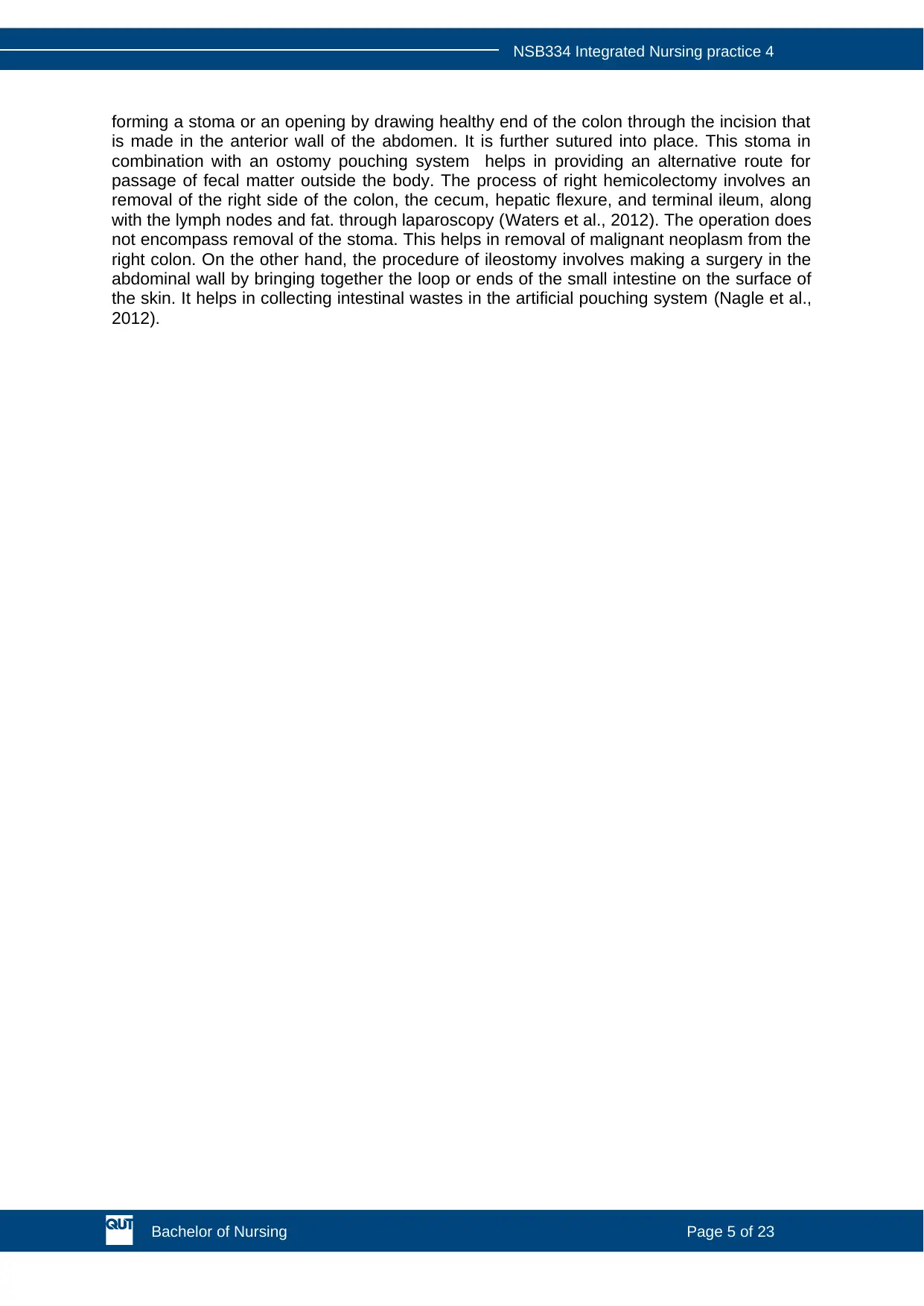
forming a stoma or an opening by drawing healthy end of the colon through the incision that
is made in the anterior wall of the abdomen. It is further sutured into place. This stoma in
combination with an ostomy pouching system helps in providing an alternative route for
passage of fecal matter outside the body. The process of right hemicolectomy involves an
removal of the right side of the colon, the cecum, hepatic flexure, and terminal ileum, along
with the lymph nodes and fat. through laparoscopy (Waters et al., 2012). The operation does
not encompass removal of the stoma. This helps in removal of malignant neoplasm from the
right colon. On the other hand, the procedure of ileostomy involves making a surgery in the
abdominal wall by bringing together the loop or ends of the small intestine on the surface of
the skin. It helps in collecting intestinal wastes in the artificial pouching system (Nagle et al.,
2012).
Bachelor of Nursing Page 5 of 23
NSB334 Integrated Nursing practice 4
is made in the anterior wall of the abdomen. It is further sutured into place. This stoma in
combination with an ostomy pouching system helps in providing an alternative route for
passage of fecal matter outside the body. The process of right hemicolectomy involves an
removal of the right side of the colon, the cecum, hepatic flexure, and terminal ileum, along
with the lymph nodes and fat. through laparoscopy (Waters et al., 2012). The operation does
not encompass removal of the stoma. This helps in removal of malignant neoplasm from the
right colon. On the other hand, the procedure of ileostomy involves making a surgery in the
abdominal wall by bringing together the loop or ends of the small intestine on the surface of
the skin. It helps in collecting intestinal wastes in the artificial pouching system (Nagle et al.,
2012).
Bachelor of Nursing Page 5 of 23
NSB334 Integrated Nursing practice 4

Question 3:
What two risk factors can lead to bowel cancer?
Answer:
The 2 risk factors are:
Sedentary lifestyle leading to excess deposition of body fat
Significant family history of polyps or bowel cancer
Question 4:
MrDwights BGL on admission to the ED is 22 mmol. What level should a normal
BGL be? Explain MrDwights BGL reading and the interventions in place to
address his diabetes.
Answer:
Normal values of BGL ranges from 4-6.1 mmol/L during fasting. The mean normal BGL is
about 5.5 mmol/L. A BGL of 22mmol represents hyperglycemia, that suggests presence of
high blood sugar levels. The underlying factors that might have contributed to his condition
are related to increased consumption of carbohydrates, mental and emotional distress,
physical inactivity, obesity and infection. On arrival of the ambulance, Mr. Dwight reported
that he is diabetic. Thus, this increased BGL is due to the less insulin secretion in his body.
The primary intervention that should be implemented for lowering the blood glucose levels is
administration of insulin. The hormone is synthesized by the beta cells of the islets of
langerhans, located in the pancreas and effectively manages to convert blood glucose to
glycogen (Dall et al., 2014). There are 3 different types of insulin:
Rapid acting
Short acting
Intermediate acting
Another intervention that can be applied is related to making dietary modifications. A holistic
nutritionist should be consulted for formulating a healthy-eating plan that has low calories
and fats and is rich in nutrients and fibers. This will also help in reducing the amount of blood
glucose.
Bachelor of Nursing Page 6 of 23
NSB334 Integrated Nursing practice 4
What two risk factors can lead to bowel cancer?
Answer:
The 2 risk factors are:
Sedentary lifestyle leading to excess deposition of body fat
Significant family history of polyps or bowel cancer
Question 4:
MrDwights BGL on admission to the ED is 22 mmol. What level should a normal
BGL be? Explain MrDwights BGL reading and the interventions in place to
address his diabetes.
Answer:
Normal values of BGL ranges from 4-6.1 mmol/L during fasting. The mean normal BGL is
about 5.5 mmol/L. A BGL of 22mmol represents hyperglycemia, that suggests presence of
high blood sugar levels. The underlying factors that might have contributed to his condition
are related to increased consumption of carbohydrates, mental and emotional distress,
physical inactivity, obesity and infection. On arrival of the ambulance, Mr. Dwight reported
that he is diabetic. Thus, this increased BGL is due to the less insulin secretion in his body.
The primary intervention that should be implemented for lowering the blood glucose levels is
administration of insulin. The hormone is synthesized by the beta cells of the islets of
langerhans, located in the pancreas and effectively manages to convert blood glucose to
glycogen (Dall et al., 2014). There are 3 different types of insulin:
Rapid acting
Short acting
Intermediate acting
Another intervention that can be applied is related to making dietary modifications. A holistic
nutritionist should be consulted for formulating a healthy-eating plan that has low calories
and fats and is rich in nutrients and fibers. This will also help in reducing the amount of blood
glucose.
Bachelor of Nursing Page 6 of 23
NSB334 Integrated Nursing practice 4
⊘ This is a preview!⊘
Do you want full access?
Subscribe today to unlock all pages.

Trusted by 1+ million students worldwide

Review and recall knowledge on nasogastric tubes.
Question 5:
(a) Why does Mr Dwight have a nasogastric tube?
(b) What three routine checks need to occur of the nasogastric tube while situated in a
patient.
Answer:
a) A nasogastric intubation is followed in this case scenario for administering and
feeding oral agents and drugs to the patient. Mr. Dwight. He suffered from dysphagia
that resulted in difficulties in swallowing. The nasogastric tibue acts as a feeding tube
that makes it easier to consume the eatables as well as the medications. His inability
to eat due to continuous vomiting and lack of adequate food and liquid intake for the
past days made it necessary to administer him the nutrients and durgs using the
tube.
b) The 3 routine checks are as follows:
The placement of the tube shall be verified by ausculaing air over stomach by
using a Toomey syringe (Irving et al., 2014).
The pH content shall be checked by using a colour-coded pH paper to confirm
the presence of acidic contents in the tube.
The length of the tube shall be marked from the nose to the tube’souter end.
Bachelor of Nursing Page 7 of 23
NSB334 Integrated Nursing practice 4
Question 5:
(a) Why does Mr Dwight have a nasogastric tube?
(b) What three routine checks need to occur of the nasogastric tube while situated in a
patient.
Answer:
a) A nasogastric intubation is followed in this case scenario for administering and
feeding oral agents and drugs to the patient. Mr. Dwight. He suffered from dysphagia
that resulted in difficulties in swallowing. The nasogastric tibue acts as a feeding tube
that makes it easier to consume the eatables as well as the medications. His inability
to eat due to continuous vomiting and lack of adequate food and liquid intake for the
past days made it necessary to administer him the nutrients and durgs using the
tube.
b) The 3 routine checks are as follows:
The placement of the tube shall be verified by ausculaing air over stomach by
using a Toomey syringe (Irving et al., 2014).
The pH content shall be checked by using a colour-coded pH paper to confirm
the presence of acidic contents in the tube.
The length of the tube shall be marked from the nose to the tube’souter end.
Bachelor of Nursing Page 7 of 23
NSB334 Integrated Nursing practice 4
Paraphrase This Document
Need a fresh take? Get an instant paraphrase of this document with our AI Paraphraser
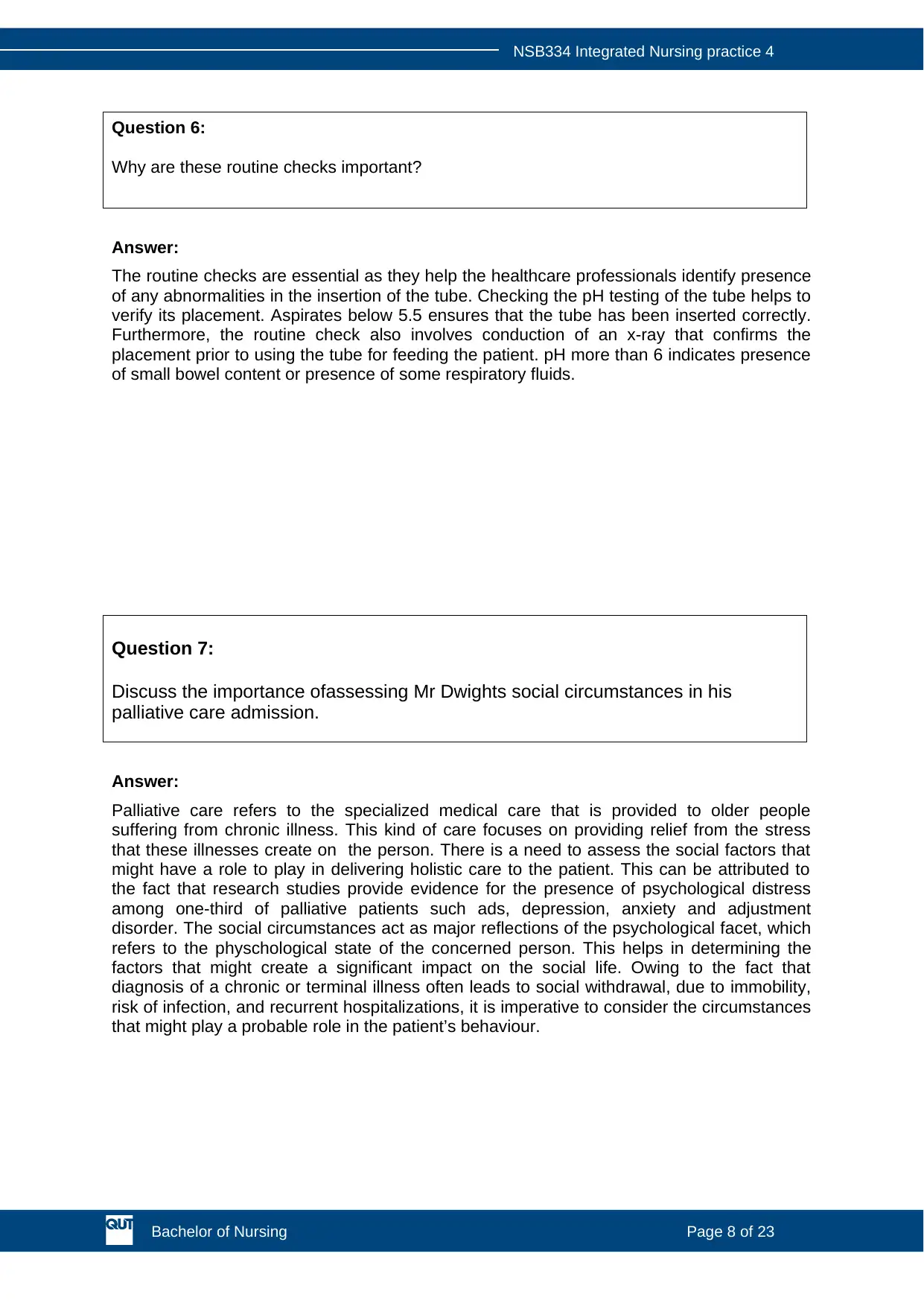
Question 6:
Why are these routine checks important?
Answer:
The routine checks are essential as they help the healthcare professionals identify presence
of any abnormalities in the insertion of the tube. Checking the pH testing of the tube helps to
verify its placement. Aspirates below 5.5 ensures that the tube has been inserted correctly.
Furthermore, the routine check also involves conduction of an x-ray that confirms the
placement prior to using the tube for feeding the patient. pH more than 6 indicates presence
of small bowel content or presence of some respiratory fluids.
Question 7:
Discuss the importance ofassessing Mr Dwights social circumstances in his
palliative care admission.
Answer:
Palliative care refers to the specialized medical care that is provided to older people
suffering from chronic illness. This kind of care focuses on providing relief from the stress
that these illnesses create on the person. There is a need to assess the social factors that
might have a role to play in delivering holistic care to the patient. This can be attributed to
the fact that research studies provide evidence for the presence of psychological distress
among one-third of palliative patients such ads, depression, anxiety and adjustment
disorder. The social circumstances act as major reflections of the psychological facet, which
refers to the physchological state of the concerned person. This helps in determining the
factors that might create a significant impact on the social life. Owing to the fact that
diagnosis of a chronic or terminal illness often leads to social withdrawal, due to immobility,
risk of infection, and recurrent hospitalizations, it is imperative to consider the circumstances
that might play a probable role in the patient’s behaviour.
Bachelor of Nursing Page 8 of 23
NSB334 Integrated Nursing practice 4
Why are these routine checks important?
Answer:
The routine checks are essential as they help the healthcare professionals identify presence
of any abnormalities in the insertion of the tube. Checking the pH testing of the tube helps to
verify its placement. Aspirates below 5.5 ensures that the tube has been inserted correctly.
Furthermore, the routine check also involves conduction of an x-ray that confirms the
placement prior to using the tube for feeding the patient. pH more than 6 indicates presence
of small bowel content or presence of some respiratory fluids.
Question 7:
Discuss the importance ofassessing Mr Dwights social circumstances in his
palliative care admission.
Answer:
Palliative care refers to the specialized medical care that is provided to older people
suffering from chronic illness. This kind of care focuses on providing relief from the stress
that these illnesses create on the person. There is a need to assess the social factors that
might have a role to play in delivering holistic care to the patient. This can be attributed to
the fact that research studies provide evidence for the presence of psychological distress
among one-third of palliative patients such ads, depression, anxiety and adjustment
disorder. The social circumstances act as major reflections of the psychological facet, which
refers to the physchological state of the concerned person. This helps in determining the
factors that might create a significant impact on the social life. Owing to the fact that
diagnosis of a chronic or terminal illness often leads to social withdrawal, due to immobility,
risk of infection, and recurrent hospitalizations, it is imperative to consider the circumstances
that might play a probable role in the patient’s behaviour.
Bachelor of Nursing Page 8 of 23
NSB334 Integrated Nursing practice 4
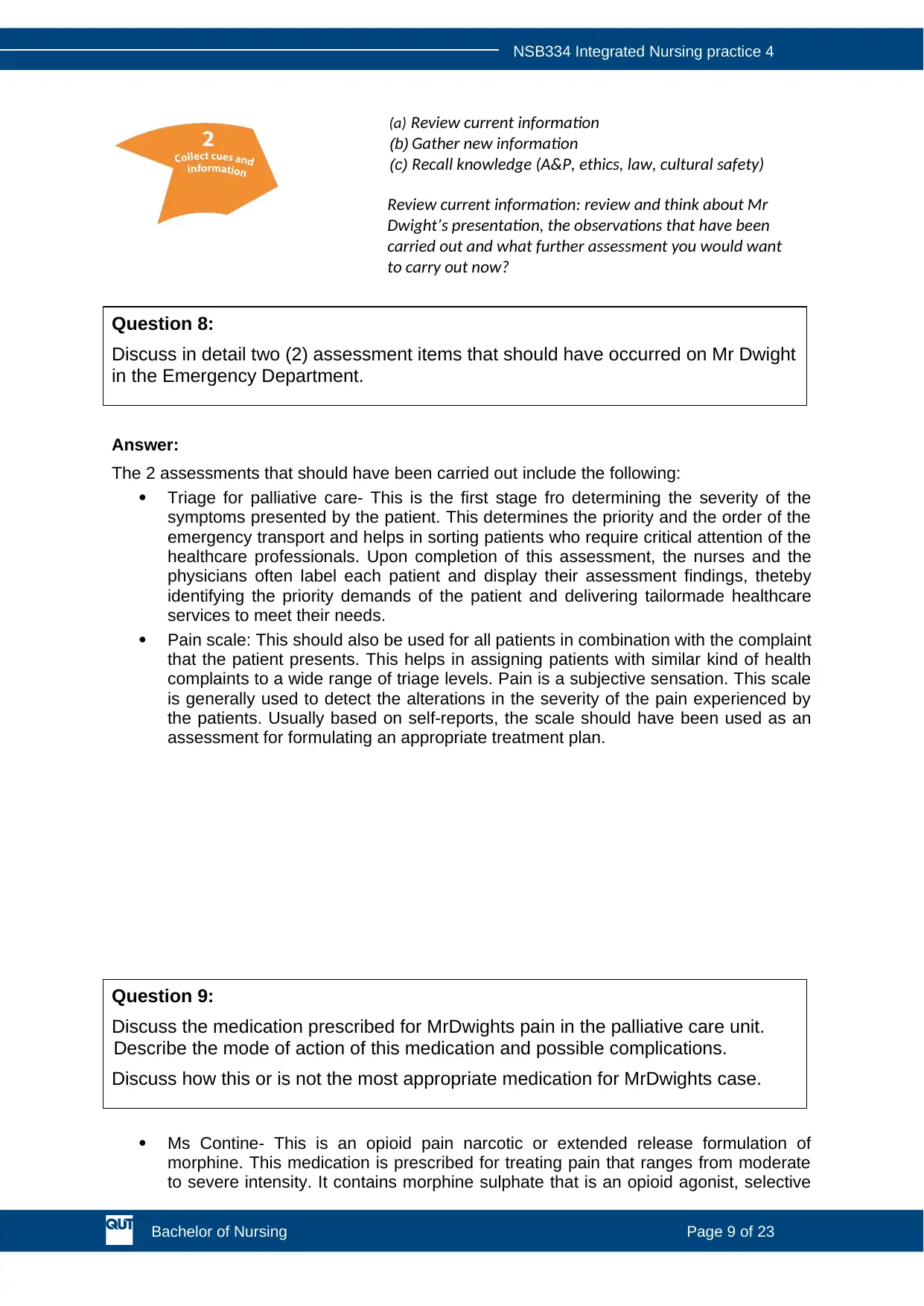
(a) Review current information
(b) Gather new information
(c) Recall knowledge (A&P, ethics, law, cultural safety)
Review current information: review and think about Mr
Dwight’s presentation, the observations that have been
carried out and what further assessment you would want
to carry out now?
Question 8:
Discuss in detail two (2) assessment items that should have occurred on Mr Dwight
in the Emergency Department.
Answer:
The 2 assessments that should have been carried out include the following:
Triage for palliative care- This is the first stage fro determining the severity of the
symptoms presented by the patient. This determines the priority and the order of the
emergency transport and helps in sorting patients who require critical attention of the
healthcare professionals. Upon completion of this assessment, the nurses and the
physicians often label each patient and display their assessment findings, theteby
identifying the priority demands of the patient and delivering tailormade healthcare
services to meet their needs.
Pain scale: This should also be used for all patients in combination with the complaint
that the patient presents. This helps in assigning patients with similar kind of health
complaints to a wide range of triage levels. Pain is a subjective sensation. This scale
is generally used to detect the alterations in the severity of the pain experienced by
the patients. Usually based on self-reports, the scale should have been used as an
assessment for formulating an appropriate treatment plan.
Question 9:
Discuss the medication prescribed for MrDwights pain in the palliative care unit.
Describe the mode of action of this medication and possible complications.
Discuss how this or is not the most appropriate medication for MrDwights case.
Ms Contine- This is an opioid pain narcotic or extended release formulation of
morphine. This medication is prescribed for treating pain that ranges from moderate
to severe intensity. It contains morphine sulphate that is an opioid agonist, selective
Bachelor of Nursing Page 9 of 23
NSB334 Integrated Nursing practice 4
(b) Gather new information
(c) Recall knowledge (A&P, ethics, law, cultural safety)
Review current information: review and think about Mr
Dwight’s presentation, the observations that have been
carried out and what further assessment you would want
to carry out now?
Question 8:
Discuss in detail two (2) assessment items that should have occurred on Mr Dwight
in the Emergency Department.
Answer:
The 2 assessments that should have been carried out include the following:
Triage for palliative care- This is the first stage fro determining the severity of the
symptoms presented by the patient. This determines the priority and the order of the
emergency transport and helps in sorting patients who require critical attention of the
healthcare professionals. Upon completion of this assessment, the nurses and the
physicians often label each patient and display their assessment findings, theteby
identifying the priority demands of the patient and delivering tailormade healthcare
services to meet their needs.
Pain scale: This should also be used for all patients in combination with the complaint
that the patient presents. This helps in assigning patients with similar kind of health
complaints to a wide range of triage levels. Pain is a subjective sensation. This scale
is generally used to detect the alterations in the severity of the pain experienced by
the patients. Usually based on self-reports, the scale should have been used as an
assessment for formulating an appropriate treatment plan.
Question 9:
Discuss the medication prescribed for MrDwights pain in the palliative care unit.
Describe the mode of action of this medication and possible complications.
Discuss how this or is not the most appropriate medication for MrDwights case.
Ms Contine- This is an opioid pain narcotic or extended release formulation of
morphine. This medication is prescribed for treating pain that ranges from moderate
to severe intensity. It contains morphine sulphate that is an opioid agonist, selective
Bachelor of Nursing Page 9 of 23
NSB334 Integrated Nursing practice 4
⊘ This is a preview!⊘
Do you want full access?
Subscribe today to unlock all pages.

Trusted by 1+ million students worldwide
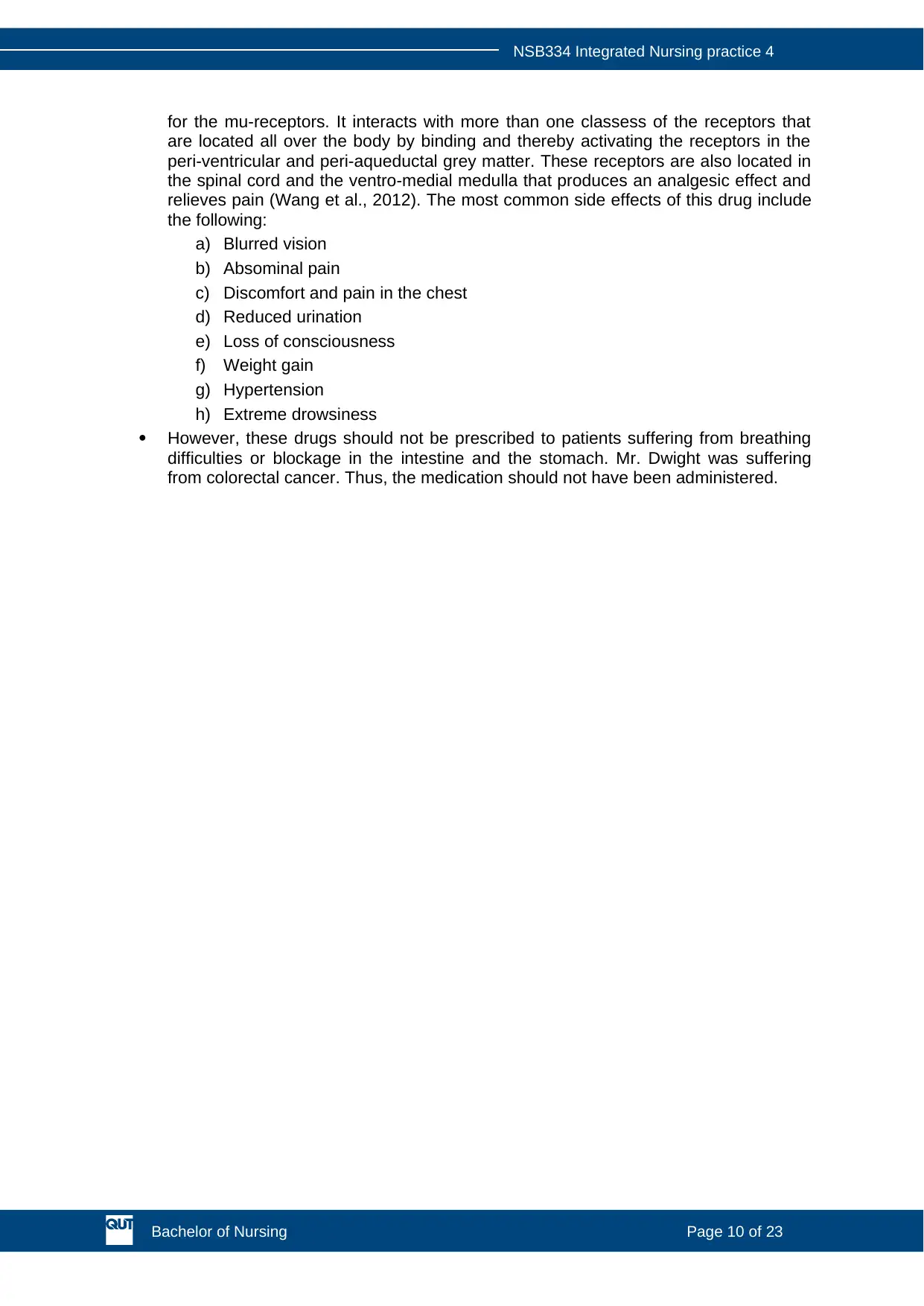
for the mu-receptors. It interacts with more than one classess of the receptors that
are located all over the body by binding and thereby activating the receptors in the
peri-ventricular and peri-aqueductal grey matter. These receptors are also located in
the spinal cord and the ventro-medial medulla that produces an analgesic effect and
relieves pain (Wang et al., 2012). The most common side effects of this drug include
the following:
a) Blurred vision
b) Absominal pain
c) Discomfort and pain in the chest
d) Reduced urination
e) Loss of consciousness
f) Weight gain
g) Hypertension
h) Extreme drowsiness
However, these drugs should not be prescribed to patients suffering from breathing
difficulties or blockage in the intestine and the stomach. Mr. Dwight was suffering
from colorectal cancer. Thus, the medication should not have been administered.
Bachelor of Nursing Page 10 of 23
NSB334 Integrated Nursing practice 4
are located all over the body by binding and thereby activating the receptors in the
peri-ventricular and peri-aqueductal grey matter. These receptors are also located in
the spinal cord and the ventro-medial medulla that produces an analgesic effect and
relieves pain (Wang et al., 2012). The most common side effects of this drug include
the following:
a) Blurred vision
b) Absominal pain
c) Discomfort and pain in the chest
d) Reduced urination
e) Loss of consciousness
f) Weight gain
g) Hypertension
h) Extreme drowsiness
However, these drugs should not be prescribed to patients suffering from breathing
difficulties or blockage in the intestine and the stomach. Mr. Dwight was suffering
from colorectal cancer. Thus, the medication should not have been administered.
Bachelor of Nursing Page 10 of 23
NSB334 Integrated Nursing practice 4
Paraphrase This Document
Need a fresh take? Get an instant paraphrase of this document with our AI Paraphraser
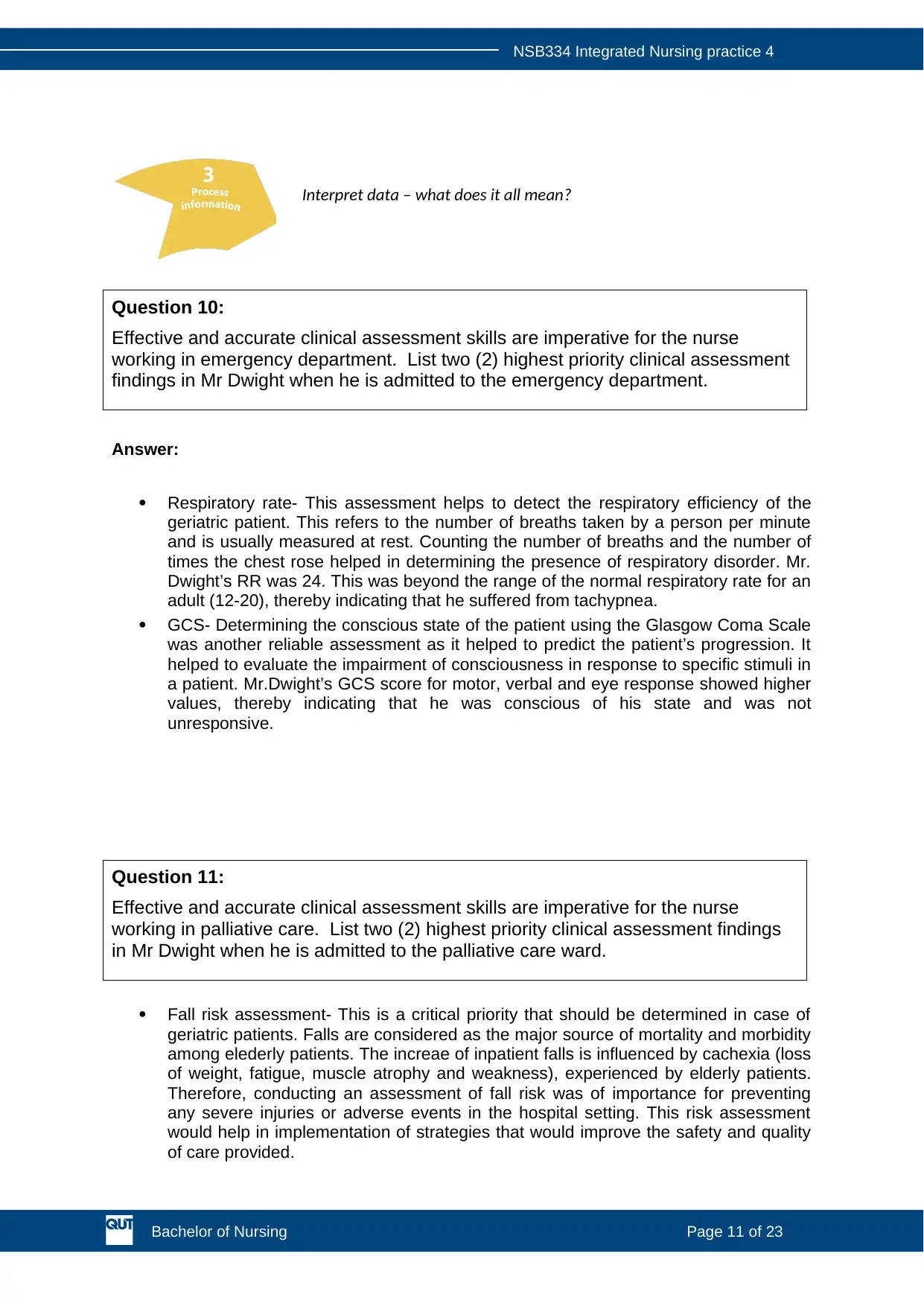
Interpret data – what does it all mean?
Question 10:
Effective and accurate clinical assessment skills are imperative for the nurse
working in emergency department. List two (2) highest priority clinical assessment
findings in Mr Dwight when he is admitted to the emergency department.
Answer:
Respiratory rate- This assessment helps to detect the respiratory efficiency of the
geriatric patient. This refers to the number of breaths taken by a person per minute
and is usually measured at rest. Counting the number of breaths and the number of
times the chest rose helped in determining the presence of respiratory disorder. Mr.
Dwight’s RR was 24. This was beyond the range of the normal respiratory rate for an
adult (12-20), thereby indicating that he suffered from tachypnea.
GCS- Determining the conscious state of the patient using the Glasgow Coma Scale
was another reliable assessment as it helped to predict the patient’s progression. It
helped to evaluate the impairment of consciousness in response to specific stimuli in
a patient. Mr.Dwight’s GCS score for motor, verbal and eye response showed higher
values, thereby indicating that he was conscious of his state and was not
unresponsive.
Question 11:
Effective and accurate clinical assessment skills are imperative for the nurse
working in palliative care. List two (2) highest priority clinical assessment findings
in Mr Dwight when he is admitted to the palliative care ward.
Fall risk assessment- This is a critical priority that should be determined in case of
geriatric patients. Falls are considered as the major source of mortality and morbidity
among elederly patients. The increae of inpatient falls is influenced by cachexia (loss
of weight, fatigue, muscle atrophy and weakness), experienced by elderly patients.
Therefore, conducting an assessment of fall risk was of importance for preventing
any severe injuries or adverse events in the hospital setting. This risk assessment
would help in implementation of strategies that would improve the safety and quality
of care provided.
Bachelor of Nursing Page 11 of 23
NSB334 Integrated Nursing practice 4
Question 10:
Effective and accurate clinical assessment skills are imperative for the nurse
working in emergency department. List two (2) highest priority clinical assessment
findings in Mr Dwight when he is admitted to the emergency department.
Answer:
Respiratory rate- This assessment helps to detect the respiratory efficiency of the
geriatric patient. This refers to the number of breaths taken by a person per minute
and is usually measured at rest. Counting the number of breaths and the number of
times the chest rose helped in determining the presence of respiratory disorder. Mr.
Dwight’s RR was 24. This was beyond the range of the normal respiratory rate for an
adult (12-20), thereby indicating that he suffered from tachypnea.
GCS- Determining the conscious state of the patient using the Glasgow Coma Scale
was another reliable assessment as it helped to predict the patient’s progression. It
helped to evaluate the impairment of consciousness in response to specific stimuli in
a patient. Mr.Dwight’s GCS score for motor, verbal and eye response showed higher
values, thereby indicating that he was conscious of his state and was not
unresponsive.
Question 11:
Effective and accurate clinical assessment skills are imperative for the nurse
working in palliative care. List two (2) highest priority clinical assessment findings
in Mr Dwight when he is admitted to the palliative care ward.
Fall risk assessment- This is a critical priority that should be determined in case of
geriatric patients. Falls are considered as the major source of mortality and morbidity
among elederly patients. The increae of inpatient falls is influenced by cachexia (loss
of weight, fatigue, muscle atrophy and weakness), experienced by elderly patients.
Therefore, conducting an assessment of fall risk was of importance for preventing
any severe injuries or adverse events in the hospital setting. This risk assessment
would help in implementation of strategies that would improve the safety and quality
of care provided.
Bachelor of Nursing Page 11 of 23
NSB334 Integrated Nursing practice 4

Cognition assessment- This helps in determining the presence of symptoms related
to delirium or confusional test among patients, which in turn causes a decline from
the baseline level of mental functioning. This is essential as it helps in identification of
disorganized behaviour, attention deficits, and fluctuating course. Therefore, it
facilitates accurate diagnosis of disorders that can impair thinking in the patient.
Bachelor of Nursing Page 12 of 23
NSB334 Integrated Nursing practice 4
to delirium or confusional test among patients, which in turn causes a decline from
the baseline level of mental functioning. This is essential as it helps in identification of
disorganized behaviour, attention deficits, and fluctuating course. Therefore, it
facilitates accurate diagnosis of disorders that can impair thinking in the patient.
Bachelor of Nursing Page 12 of 23
NSB334 Integrated Nursing practice 4
⊘ This is a preview!⊘
Do you want full access?
Subscribe today to unlock all pages.

Trusted by 1+ million students worldwide
1 out of 23
Your All-in-One AI-Powered Toolkit for Academic Success.
+13062052269
info@desklib.com
Available 24*7 on WhatsApp / Email
![[object Object]](/_next/static/media/star-bottom.7253800d.svg)
Unlock your academic potential
Copyright © 2020–2025 A2Z Services. All Rights Reserved. Developed and managed by ZUCOL.


